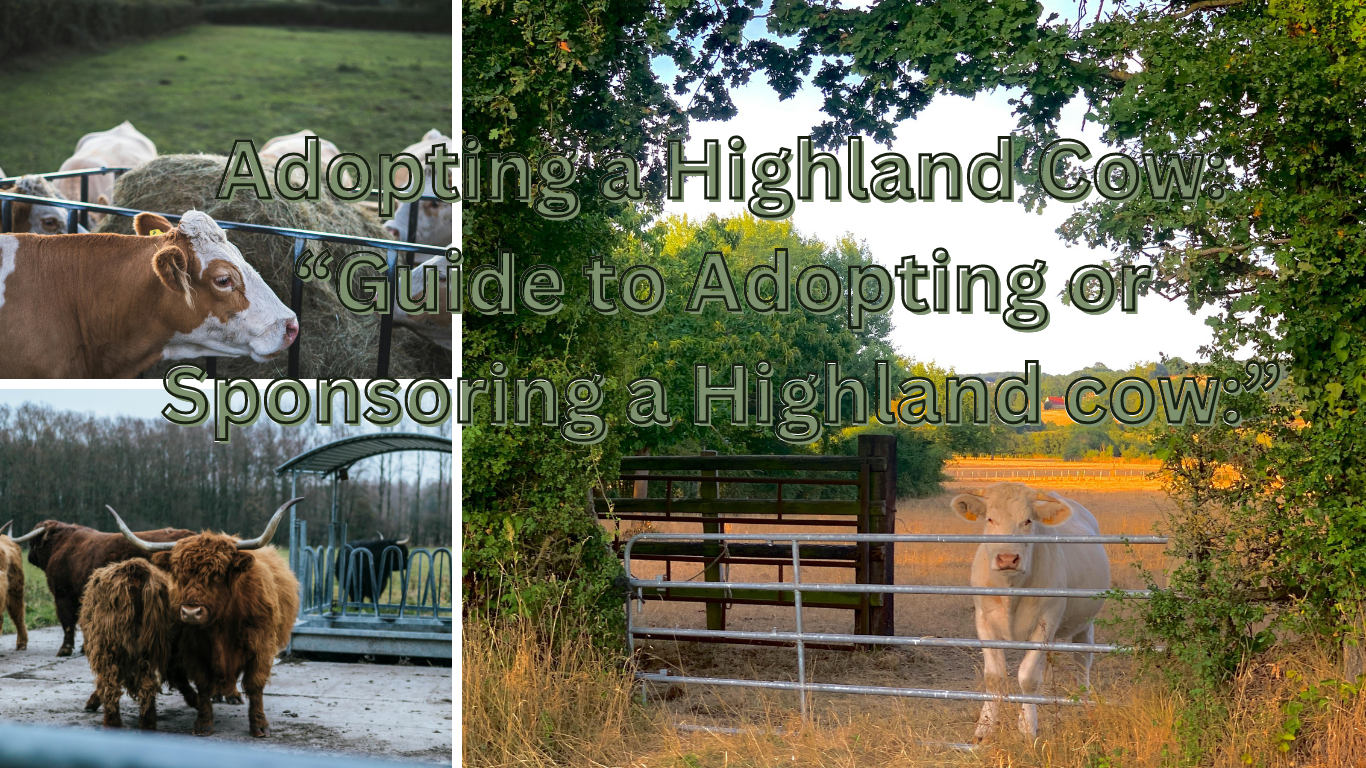
1. Introduction to Highland Cows:
Highland cows, also known as Highland cattle, are a Scottish breed recognised for their distinctive long horns and shaggy, wavy coat. Originating from the Highlands and Western Isles of Scotland, these cows are well adapted to the cold and harsh climate.
Their double-layered coat provides excellent insulation to keep them warm in winter and cool in summer. Known for their gentle and friendly temperament, Highland cows are popular with farmers and cattle enthusiasts.
They are also hardy and resilient, able to thrive on rough terrain and poor quality forage, making them a low-maintenance breed. Their unique appearance and manageable nature make them an attractive option for adoption or sponsorship, providing both companionship and practical benefits.
2. Adoption vs. Sponsorship:
Adoption:
Adopting a Highland cow involves taking full responsibility for the animal’s care and well-being. This includes providing suitable housing, proper nutrition, regular veterinary care, and overall maintenance.
Adoptive owners need to ensure the cow has adequate shelter to protect it from inclement weather, its diet is primarily composed of grass and hay, and regular health checkups to prevent disease.
Additionally, adopting a Highland cow requires a commitment to maintaining clean living conditions and secure fencing to keep the cow safe.
While adoption requires time, effort, and financial resources, it offers the rewards of companionship, practical experience with animal care, and the satisfaction of supporting a unique and hardy breed.
Sponsorship:
Highland cow sponsorship involves providing financial support for the care of a cow without taking on the full responsibility of ownership. This usually means contributing to the costs of housing, food and veterinary care, while the day-to-day management of the cow is handled by a farm or sanctuary.
Sponsors often receive regular updates, photos and sometimes visiting rights to see the cow. Sponsorship is a great option for people who want to support and connect with Highland cows, but may not have the resources or space to adopt one themselves.
It offers the satisfaction of contributing to the well-being of these animals and supporting conservation or agricultural initiatives.
3. Responsibilities of Adopting a Highland Cow:
a. Housing:
Provide a sturdy shelter to protect the cow from extreme weather conditions such as rain, snow and heat.
b. Feeding:
Ensure a diet of primarily grass and hay, supplementing with minerals and vitamins as needed. Adequate access to fresh water is a must.
c. Healthcare:
Schedule regular veterinary checkups, vaccinations and treatments for parasites. Maintain a hoof care routine to prevent problems.
d. Maintenance:
Keep living conditions clean and safe. This includes regular cleaning of the shelter and ensuring that fencing is intact to prevent escapes and protect against predators.
e. Time and attention:
Spend time with the cow to build trust and ensure she is healthy and happy. Monitor any signs of illness or discomfort and address them immediately
4. Benefits of Adopting or Sponsoring:
a. Compatibility:
Highland cows are gentle and can form strong bonds with their caretakers, providing emotional and social enrichment.
b. Environmental impact:
They help manage grasslands by grazing pastures, promoting biodiversity and maintaining healthy ecosystems.
c. Educational opportunities:
Caring for a Highland cow provides practical education about animal husbandry, sustainable farming practices and livestock management.
d. Support for conservation:
Sponsoring a Highland cow, especially through the sanctuary, contributes to the preservation of this unique breed and supports agricultural heritage.
e. Personal satisfaction:
Both adoption and sponsoring provide the rewarding experience of contributing to the well-being and conservation of these animals, increasing the connection to nature and rural life.
5. Legal and Financial Considerations:
a. Permits and regulations:
Check local laws and regulations regarding livestock ownership. This may involve obtaining specific permits or meeting zoning requirements.
b. Initial costs:
Consider the purchase price of a Highland cow, which can vary based on age, health and pedigree.
c. Ongoing expenses:
Budget for regular expenses such as feed, veterinary care, housing maintenance and any necessary supplements or medications.
d. Insurance:
Explore livestock insurance options to cover potential health problems or accidents.
e. Long-term commitment:
Make sure you’re prepared for long-term care of a cow, which can live up to 20 years, requiring an ongoing financial and time investment.
6. Finding a Highland Cow:
a. Breeders:
Research and contact reputable breeders who specialize in Highland cows. Look for breeders with a good track record of healthy, well-cared-for animals.
b. Farms:
Visit local farms where Highland cows may be for sale. This will allow you to see the conditions in which the cows are raised and assess their health and temperament first-hand.
c. Sanctuaries:
Consider adopting or sponsoring a cow through an animal sanctuary. This option often supports conservation efforts and provides homes to cows in need.
d. Livestock shows and auctions:
Attend livestock shows and auctions where Highland cows may be available for purchase. This can be a good opportunity to meet breeders and see a variety of animals.
e. Online resources:
Use online directories and agricultural websites that list Highland cows for sale or adoption. Make sure the sources are reliable and provide detailed information about the animals and their care.
CONCLUSION:
Adopting or sponsoring a Highland cow can be a rewarding experience, providing companionship, educational opportunities, and environmental benefits. Make sure you are prepared for the responsibilities and costs involved in providing a happy, healthy life for your new bovine friend.

